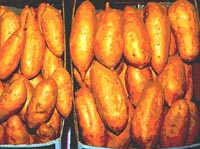Resource Library
Plant of the Week: Yam (Sweet Potato)
The University of Arkansas System Division of Agriculture does not promote, support or recommend plants featured in "Plant of the Week." Please consult your local Extension office for plants suitable for your region.
Plant of the Week
Sweet Potato, Yam
Latin: Ipomoea batatas

Our Thanksgiving tables offer an interesting mixture of foods and present a culinary
snapshot of American history that harkens back to the first days of European settlement.
Everything from corn pudding to cranberries and sweet potato casserole has an historic
footnote to the history of our nation. It is appropriate that the sweet potato, a
fall-harvested crop, should have its place at our holiday table.
The sweet potato is a tropical perennial vine of the morning glory family that was
cultivated by native tribes throughout the Caribbean basin well before Columbus arrived.
On his first trip, he was offered roasted sweet potatoes. The edible portion of the
sweet potato is a swollen root used for starchy storage that can attain considerable
size. Being tropical in nature, sweet potatoes are sensitive to cold weather and will
break down internally if exposed to temperatures below 55 degrees F.
On his second trip, Columbus returned to the Americas with a fleet of 17 ships and1,500
men. He established the first town in the Americas, Isabella in the modern day Dominican
Republic. He returned to Spain with a number of unhappy Indians, 60 parrots, three
gold nuggets and roots of the sweet potato.
Sweet potatoes quickly spread around the tropical regions of the world and became
a staple in many countries. The red and orange fleshed types are an excellent food
source rich in beta carotene, the precursor to vitamin A. Henry VIII (1491-1547),
obviously a connoisseur of fine foods if his portraits are any indication, liked his
sweet potatoes baked into pies.
A surviving recipe from that era calls for sweet potatoes to be combined with quinces,
dates, egg yolks, sugar, rose water, spices, a quart of wine and brains of three or
four cock sparrows for added zest. To my untrained and always appreciative taste buds,
the sweet potato pies I have eaten in Little Rock taste much like pumpkin pie but
with a sweeter after-taste.
Throughout the South, sweet potatoes are often called yams, especially the moist,
orange-fleshed types. This apparently is a corruption of an African word "nyam" that
African slaves used to describe the sweet potato that became a staple of their diet
on Southern plantations. In Africa, a common food was a tuberous root belonging to
the genus Dioscorea to which they applied this name.
Sweet potato was an ideal food for plantation owners because the roots, provided
they were stored correctly, could be kept for six to eight months.
Sweet potatoes can be grown in the home garden with slips planted only after the
soil has thoroughly warmed in the spring.
Slips are vegetative shoots that are harvested from stored roots that are forced
into growth in the spring as temperatures begin rising. These slips are 8 inches to10
inches long and contain no roots at planting, but quickly root once planted in moist
soil.
Sandy soils produce the highest quality sweet potatoes. A 10-foot row of plants,
with plants spaced about a foot apart, will yield up to 15 pounds of roots. Depending
on the cultivar planted, plants mature in 90 to 110 days from planting.
The ornamental sweet potato vines we see in gardens produce an edible taproot that
is often softball size or larger. Unfortunately, the root is white fleshed so it would
make an anemic sweet potato casserole.
By: Gerald Klingaman, retired
Extension Horticulturist - Ornamentals
Extension News - November 17, 2000
The University of Arkansas System Division of Agriculture does not maintain lists of retail outlets where these plants can be purchased. Please check your local nursery or other retail outlets to ask about the availability of these plants for your growing area.